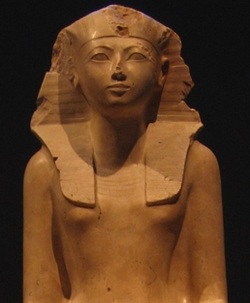 By Yoon Joung Lee There have been four female pharaohs total in Ancient Egypt. Although Cleopatra was the most well-known female pharaoh, Hatshepsut had the most powerful influence from 1508 to 1458 BC. Hatshepsut was the fifth pharaoh of the eighteenth dynasty of Ancient Egypt. Hatshepsut married Thutmosis II, but the marriage didn’t produce children. However, Thutmosis’s secondary wife, Isis, produced a son named Thutmosis III. However, his father, Thutmosis II, died when he was only 12 years old. Since Thutmosis III was too young to become a ruler, Hatshepsut assumed the role of regent on his behalf and the length of her reign was 22 years, which was much longer than any other female pharaohs in Ancient Egypt. Her era is considered to be a prosperous and a long peaceful era. There is no suggestion of military activities on her part. However, some history experts say that what we can find about her today may not be all since many of her texts are defaced, amended, or erased after her death. Therefore, there is a strong possibility that her war record is incomplete. She re-built trading relationships that were lost during a foreign occupation. This re-establishment of trading networks brought great wealth to the eighteenth dynasty of Egypt. This wealth enabled her to pursue hundreds of construction projects in both Upper Egypt and Lower Egypt. She had monuments constructed at the Temple of Karnak. She built twin obelisks which were the tallest at that time in the world. She also built another project called Karnak’s Red Chapel which stood between her two obelisks. The Temple of Pakhet was built by her at Beni Hasan in the Minya Governorate south of Al Minya. However, the masterpiece of her building projects was her mortuary temple built in a complex at Deir eil-Bahri. This temple is at a site on the West Bank of the Nile River. Her buildings including Deir eil-Bahri are considered to be a significant advance in architecture. After 22 years of competent rule, she left the scene. She died 9 months into her 22nd regal? year as king. There is no record about the cause of her death. Although her mummy has never been positively identified, the medical evidence with her assumable mummy indicates that she suffered from diabetes and died by bone cancer. Many experts also assume that she might not have received an honorable burial because her coffin has been preserved. Please explain a little how an honorable burial depends on the coffin. Around at the end of the reign of Thutmose III and the time of his son’s reign, there were some attempts to eliminate Hatsheput's historical and pharaonic records. Her images and sculptures were chiseled of from some stone walls, and her numerous statues at the Deir el-Bahri were torn down, smashed, or disfigured before being buried in a pit. It is unclear why this happened, but we can only assume that there were some counter-powers against her. Amenhotep II became a co-regent of Thutmose III before his death. Amenhotep is suspected to be the defacer during the end of reign of Hashpetsut. He is documented as having usurped many of Hatchepsut’s accomplishments during his own reign. Although many of her records are missing or destroyed, her great works as a female ruler are still complemented by people worldwide. Her monument is still filled with today’s scholars and tourists. With admiration, these people are not only there for visiting historical monuments themselves, but for remembering a remarkable female pharaoh who was responsible for their construction and her capable leadership of the great Egyptian Empire. Comments are closed.
|
Archives
July 2017
Categories
All
|
 RSS Feed
RSS Feed